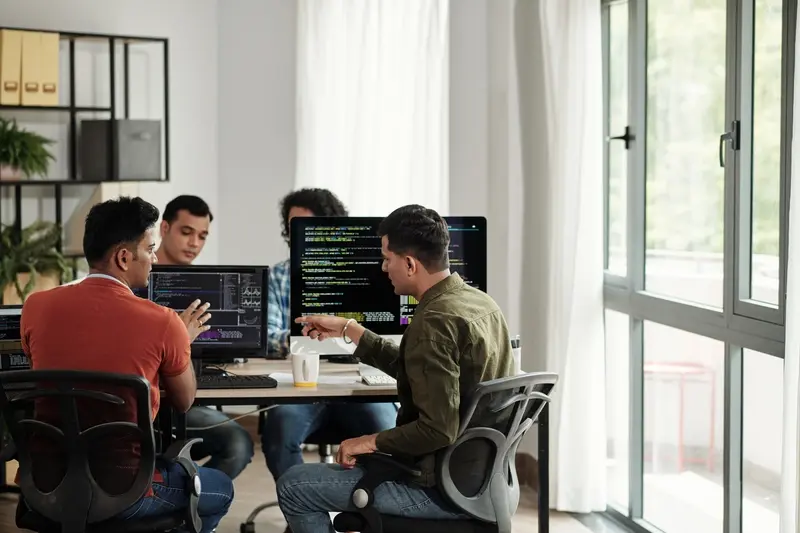What's The Difference Between Peer Review And Code Review?
Did you know that bugs caught during peer review cost 10 times less to fix than those discovered after deployment? Yet many mobile app development teams still confuse peer review with code review—or worse, skip one entirely. These two quality processes might sound similar, but they serve completely different purposes in building robust mobile applications.
Over the years working with development teams, I've noticed this confusion leads to gaps in quality assurance that can make or break an app's success. Teams either duplicate efforts unnecessarily or miss critical issues that could have been caught with the right review approach. The thing is, both review types are needed; they just work at different stages and focus on different aspects of your mobile app.
The best mobile apps aren't built by perfect developers—they're built by teams that know how to review their work properly at every stage.
Understanding when to use peer review versus code review can transform your development process. Whether you're building your first mobile app or you're part of an experienced team, getting these review types right will save you time, money, and countless headaches down the road. Let's explore what makes each approach unique and how they work together to create better mobile applications.
What Is Peer Review
Let me start by saying that peer review in mobile app development isn't what you might think it is—it's not just about checking code. Having worked with development teams for years, I've seen too many people confuse this with code review, and honestly, it's costing them quality releases.
Peer review is a broader evaluation process where team members examine each other's work before it goes live. This includes everything from user interface designs and user experience flows to documentation, testing strategies, and yes, sometimes code too. The key difference? It's about the bigger picture rather than just syntax and logic.
What Gets Reviewed in Peer Review
- App design mockups and prototypes
- User journey maps and wireframes
- Feature specifications and requirements
- Testing plans and quality assurance strategies
- Technical architecture decisions
- Project documentation and guidelines
The beauty of peer review lies in its collaborative nature. When Sarah from design shares her latest screen layouts with the development team, she's getting feedback from people who understand both the technical constraints and user needs. This catches potential issues before they become expensive problems—trust me, fixing a fundamental design flaw after development starts is painful for everyone involved.
What Is Code Review
Code review is when developers examine each other's code before it becomes part of the main mobile app. Think of it like having a colleague check your work before you hand it in—except this colleague is looking at the actual programming code that makes your app function.
During code review, another developer (or sometimes several developers) will read through the new code line by line. They're checking for bugs, security issues, and whether the code follows the team's standards. It's not about finding fault; it's about catching problems before users do.
Set up automated tools to catch basic issues like formatting problems or simple bugs—this frees up your team to focus on the more complex stuff during manual reviews.
What Code Reviewers Look For
Code reviewers focus on technical aspects that could affect your mobile app's performance and security. Here's what they typically examine:
- Bugs and potential crashes
- Security vulnerabilities
- Code that's hard to understand or maintain
- Performance issues that might slow down the app
- Consistency with team coding standards
The best code reviews happen when developers can discuss the code together—not just point out problems. This creates a learning environment where junior developers pick up skills from senior team members, and even experienced developers can learn new approaches to solving problems.
Key Differences Between Peer Review and Code Review
Now that we've covered what peer review and code review are, let's talk about how they differ—because trust me, mixing these up can cause real headaches in your development process. I've seen teams waste weeks because they weren't clear on which type of review they needed.
The biggest difference is scope. Peer review looks at the big picture stuff like whether your app idea makes sense, if the user experience flows properly, and whether you're solving the right problem. Code review gets into the nitty-gritty technical details—checking if your functions work correctly, if there are security holes, and whether the code follows your team's standards.
Who Gets Involved
Peer review typically involves designers, product managers, stakeholders, and sometimes even potential users. Code review is mainly developers, technical leads, and quality assurance testers—people who can actually read and understand the code.
When They Happen
Here's where timing matters. Peer review happens early in the process, often before any code gets written. Code review happens during development, usually when developers want to merge their work into the main codebase.
| Aspect | Peer Review | Code Review |
|---|---|---|
| Focus | Concepts and design | Technical implementation |
| Timing | Early planning stages | During development |
| Participants | Mixed team roles | Technical team members |
Both are valuable, but they serve completely different purposes in your mobile app development journey.
When to Use Peer Review in Mobile App Development
Peer review works best when you're tackling the bigger picture stuff in your mobile app project. I'm talking about those moments when you need fresh eyes on your overall approach, design decisions, or technical architecture. It's not about finding semicolons in the wrong place—that's what code review is for.
Use peer review during the planning stages when you're mapping out your app's structure. Got a complex feature that could be built three different ways? That's prime peer review territory. Your team can weigh in on which approach makes the most sense for your users and your timeline.
Design and User Experience Decisions
When you're working on user interface designs or planning user flows, peer review becomes invaluable. Different team members bring different perspectives on how users might interact with your mobile app. A developer might spot technical constraints whilst a designer focuses on usability issues.
The best mobile apps come from teams that challenge each other's assumptions early and often
Technical Architecture Reviews
Before you start coding major features, gather your team for peer review sessions. Discuss database structures, API designs, and integration points. These quality processes catch potential problems before they become expensive mistakes. Trust me—fixing architectural issues after development starts is like trying to change the foundations of a house whilst people are living in it.
When to Use Code Review in Mobile App Development
Code review works best when you need to catch bugs before they reach users. I've seen teams save weeks of debugging simply by having another developer check their work first—it's that powerful. Code review shines when you're working with complex features, integrating third-party services, or building security-sensitive parts of your app.
The timing matters too. Code review fits perfectly into your development workflow when developers finish individual features or fix bugs. Unlike peer review which happens at project milestones, code review happens continuously throughout development. This means problems get caught early when they're cheap and easy to fix.
Best Situations for Code Review
- New team members joining the project
- Working with payment systems or user data
- Building complex algorithms or business logic
- Integrating with external APIs
- Making changes to core app functionality
- Working under tight deadlines where bugs are costly
I always recommend code review when your app handles sensitive information like passwords or payment details. The extra pair of eyes can spot security vulnerabilities that might slip past the original developer. It's also brilliant for maintaining code quality standards across your team—everyone writes code slightly differently, but code review helps keep things consistent and readable for future maintenance.
Common Mistakes Teams Make with Review Types
After working with countless mobile app development teams over the years, I've noticed the same mistakes popping up again and again when it comes to review types. The biggest one? Teams picking the wrong review for the wrong situation. I've seen brilliant developers waste hours doing line-by-line code reviews on prototype work that was never meant to see production—talk about missing the point!
Another classic mistake is treating both review types the same way. Some teams apply the same rigid standards to peer reviews as they do to code reviews, which completely defeats the purpose. Peer reviews should be about big-picture thinking and creative problem-solving, not nitpicking variable names.
The Most Common Review Mistakes
- Using code review when peer review would be more appropriate
- Skipping reviews entirely during "rush" periods
- Having too many people in code reviews (slows everything down)
- Not having clear criteria for what needs reviewing
- Mixing feedback types in the same review session
The worst mistake I see is teams abandoning quality processes when deadlines get tight. This is exactly when you need reviews the most! A quick peer review can save days of rework later.
Set clear guidelines for when to use each review type and stick to them—your future self will thank you when bugs are caught early instead of in production.
Conclusion
After working on countless mobile app projects over the years, I can tell you that getting your review processes right makes all the difference between a smooth development cycle and one that keeps you up at night. Peer review and code review aren't competing approaches—they're complementary tools that serve different purposes in your development toolkit.
Peer review shines when you need fresh perspectives on big decisions, architecture choices, or when you're stuck on a tricky problem. It's your safety net for catching issues before they become expensive mistakes. Code review, on the other hand, is your quality gatekeeper—making sure every line of code meets your standards before it goes live.
The teams that get this right use both approaches strategically. They don't just review everything or nothing; they understand when each type of review adds the most value. They avoid the common pitfalls like making reviews too formal, too long, or too focused on minor details.
At the end of the day, both peer review and code review are about building better apps and stronger teams. When you implement them thoughtfully, they don't slow you down—they help you move faster by catching problems early and sharing knowledge across your team.
Share this
Subscribe To Our Learning Centre
You May Also Like
These Related Guides

What Tools Do Professional Teams Use For Code Reviews?

What Is Code Review And Why Should You Care About It?



